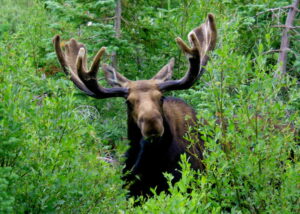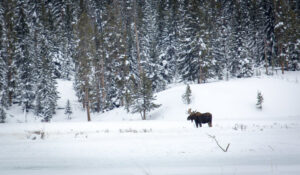Moose

“Shiras Moose – Grand Teton National Park” by Al_HikesAZ is licensed with CC BY-NC 2.0.
The moose (North America) or elk (Eurasia), Alces alces is a member of the New World deer subfamily and is the largest and heaviest extant species in the Deer family. Moose are distinguished by the broad, palmate (open-hand shaped) antlers of the males; other members of the deer family have antlers with a dendritic (“twig-like“) configuration. Moose typically inhabit boreal forests and temperate broadleaf and mixed forests of the Northern Hemisphere in temperate to subarctic climates. Hunting and other human activities have caused a reduction in the size of the moose’s range over time.
Table of Content
#1
Overview
Moose have been reintroduced to some of their former habitats. Currently, most moose are found in Canada, Alaska, New England (with Maine having the most of the lower 48 states), Fennoscandia, Baltic states, and Russia.
Their diet consists of both terrestrial and aquatic vegetation. The most common moose predators are the gray wolf along with bears and humans. Unlike most other deer species, moose are solitary animals and do not form herds. Although generally slow-moving and sedentary, moose can become aggressive and move quickly if angered or startled. Their mating season in the autumn features energetic fights between males competing for a female.
#2
Habitat

“Bull moose along Soda Butte Creek” by YellowstoneNPS is marked under CC PDM 1.0.
Moose require habitat with adequate edible plants (e.g., pond grasses, young trees and shrubs), cover from predators, and protection from extremely hot or cold weather. Moose travel among different habitats with the seasons to address these requirements. Moose are cold-adapted mammals with thickened skin, dense, heat-retaining coat, and a low surface: volume ratio, which provides excellent cold tolerance but poor heat tolerance.
Moose survive hot weather by accessing shade or cooling wind, or by immersion in cool water. In hot weather, moose are often found wading or swimming in lakes or ponds. When heat-stressed, moose may fail to adequately forage in summer and may not gain adequate body fat to survive the winter. Also, moose cows may not calve without adequate summer weight gain.
Moose require access to both young forest for browsing and mature forest for shelter and cover. Forest disturbed by fire and logging promotes the growth of fodder for moose. Moose also require access to mineral licks, safe places for calving and aquatic feeding sites.
Moose avoid areas with little or no snow as this increases the risk of predation by wolves and avoid areas with deep snow, as this impairs mobility. Thus, moose select habitat on the basis of trade-offs between risk of predation, food availability, and snow depth.
Competition From Bison
With reintroduction of bison into boreal forest, there was some concern that bison would compete with moose for winter habitat, and thereby worsen the population decline of moose. However, this does not appear to be a problem. Moose prefer sub-alpine shrublands in early winter, while bison prefer wet sedge valley meadowlands in early-winter. In late-winter, moose prefer river valleys with deciduous forest cover or alpine terrain above the tree line, while bison preferred wet sedge meadowlands or sunny southern grassy slopes.
#3
Populations and Geographical Location
1. North America
In Canada
-
There are an estimated 500,000 to 1,000,000 moose with 150,000 in Newfoundland in 2007 descended from just four that were introduced in the 1900s.
In United States
There are estimated to be around 300,000, as follows:
-
Alaska’s state Department of Fish and Game estimated 200,000 in 2011.
-
In the Northeast, a wildlife ecologist estimated 50,000 in New York and New England in 2007, with expansion expected.
-
In the Rocky Mountain states Wyoming is said to have the largest share in its 6-state region, and its Fish and Game Commission estimated 7,692 in 2009.
-
In the Upper Midwest Michigan estimated 433 (in its Upper Peninsula) in 2011, Wisconsin Department of Natural Resources 20–40 (close to its upper-peninsula border with Michigan) in 2003, Minnesota 5600 in its northeast in 2010, and under 100 in its northwest in 2009.
-
North Dakota closed, due to low moose population, one of its moose-hunting geographic units in 2011, and issued 162 single-kill licenses to hunters, each restricted to one of the remaining nine units.
2. Europe
-
Finland found in 2009, there was a summer population of 115,000 moose.
-
In Norway there were a winter population of around 120,000 moose in 2009. In 2015 31,131 moose were shot. In 1999, a record number of 39,422 moose were shot.
-
Latvia had 21,000 moose in 2015; Estonia had 13,260 individuals
-
Poland had 2,800 individuals, and the Czech Republic 50 animals.
-
In Sweden the Summer population is estimated to be 300,000–400,000 moose. Around 100,000 are shot each fall. About 10,000 are killed in traffic accidents yearly.
-
Russia (Europe and Aisa), in 2007, had a population of approximately 600,000 moose.
#4
Diet

“Animal – Wildlife – Moose – Alaska” by blmiers2 is licensed with CC BY-NC-SA 2.0.
The moose is a browsing herbivore and is capable of consuming many types of plant or fruit. The average adult moose needs to consume 9,770 kcal (40.9 MJ) per day to maintain its body weight. Much of a moose’s energy is derived from terrestrial vegetation, mainly consisting of forbs and other non-grasses, and fresh shoots from trees such as willow and birch.
These plants are rather low in sodium, and moose generally need to consume a good quantity of aquatic plants. While much lower in energy, aquatic plants provide the moose with its sodium requirements, and as much as half of their diet usually consists of aquatic plant life.
In winter, moose are often drawn to roadways, to lick salt that is used as a snow and ice melter. A typical moose, weighing 360 kg (794 lb), can eat up to 32 kg (71 lb) of food per day.
#5
Predators

“Walking Siberian tiger” by Tambako the Jaguar is licensed with CC BY-ND 2.0
A full-grown moose has few enemies except Siberian tigers (Panthera tigris altaica) which regularly prey on adult moose, but a pack of gray wolves (Canis lupus) can still pose a threat, especially to females with calves.
Brown bears (Ursus arctos) are also known to prey on moose of various sizes, including many pregnant adult cows in some parts of Alaska and Scandinavia and even the rare bull moose, and are the only predator besides the wolf to attack moose both in Eurasia and North America. However, brown bears are more likely to take over a wolf kill or to take young moose than to hunt adult moose on their own.
American black bears (Ursus americanus) and cougars (Puma concolor) can be significant predators of moose calves in May and June and can, in rare instances, prey on adults (mainly cows rather than the larger bulls).
Wolverine (Gulo gulo) are most likely to eat moose as carrion but have killed moose, including adults, when the large ungulates are weakened by harsh winter conditions.
Killer whales (Orcinus orca) are the moose’s only known marine predator as they have been known to prey on moose swimming between islands out of North America’s Northwest Coast, however, there is at least one recorded instance of a moose preyed upon by a Greenland shark.
Reflection
There are several steps to create this web page.
1. Selecting Organizing and Integrating (SOI)
The original text is not logically arranged, so I need to select the information I need and organize them in logical reading order. I have added a table of content linked to the titles (first headings) of each section.
2. Typography
The default font type of my WordPress site is Lato. In order to make the web text clean and easy to read (improve readability), I choose another sans-serif font: Helvetica, which is also the “safest” font that has been widely used in the public and design industry. To change the font on my webpage, I need to use the HTML code “font-family: Helvetica” in the style of the <p>, <h1>, and other headings.
3. Headers, Lists, and Paragraphs
Headers are used to distinguish each section and are named according to the main idea of the content. The unordered lists are used in the population section to demonstrate cities with moose population and solve the chunking issue of the original article. Every paragraph has a 60-pixel margin to the top. The necessary white space in between also makes the blog more readable.
4. Links to Term Definition
Some of the terms involved are linked to Wikipedia for definition. At the button of the article, a link that leads to a web page of National Geographic is added for readers to read more facts about moose.
5. Tip-Tool Text
I have added “More information” as a tool text to every linked text, so when readers hover the mouse over the link, the text will appear and tell the reader “this is the link that will give you more information about this term.” The term-“sodium” with the definition inside the tool text box provides the definition directly for readers.
Summary
Besides the process mentioned above, I have also used the callouts to give additional information about moose’s competitor – bison in winter. The font size for the body paragraphs is 16 (the default setting of my WordPress site). I changed the text for image information to 12, as it is not the main content of this article, to minimize the distraction.
This might not be the perfect version for this activity, and there are always other methods to improve the readability of text used in online learning.


https://j-website.net
Best view i have ever seen !